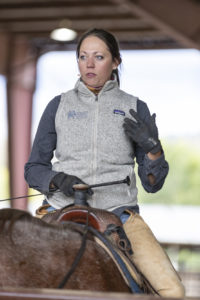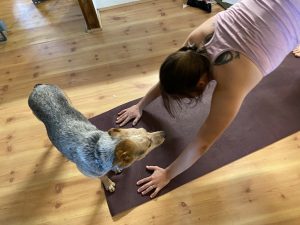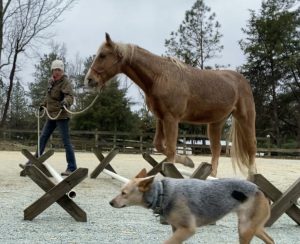Editor’s Note: Amy Skinner is a regular guest columnist and has been a horse gal since age six. She has presented twice at the Best Horse Practices Summit and is the author of To Catch a Horse: Finding the Heart of your Horsemanship.
She rides and teaches dressage and Western. Skinner has studied at the Royal Andalusian School of Equestrian Art in Spain, with Brent Graef, Leslie Desmond, and many others. Visit her website here.

Amy Skinner at the BHPS 2018
Amy writes:
Most questions I get from people about behavior put the focus on the horse. They usually take the form of asking how to get a horse to do or stop doing something. Ironically, as I learn to get along better with horses, the fewer answers I have for these questions.
Over the last decade, I’ve been on a messy but productive journey of self-development. My work with horses has gotten better and more enjoyable and further from the focus on doing or not doing things. Those behaviors happen or go away as happy byproducts of a better relationship and better self-control.
Good horsemanship is a way of life and a lifelong endeavor toward self-improvement. Not everyone aspires to make riding their life’s work, but when it comes to getting along with horses, there is no way around self-improvement. Horses can never change what nature made them; it’s up to us to change to better fit the horse-rider equation.
Here are some things every person can do for their horses. Happy side effects are improvements in overall well-being and quality of life.
- Engage in regular exercise, outside of riding. Riding requires good body awareness and a certain degree of fitness. Anything you enjoy and can stick to is great. I enjoy weight-lifting, for the balancing in motion required and confidence boosting. I like yoga for its breathing, relaxing while being fully engaged, strength, flexibility, and body awareness. These lead to better balance in the saddle, better confidence, and more fun riding.

- Develop mindfulness. This can go as deep as you want to take it. Learning to be present and to be aware of your breathing will take you a long way with horses. I like to start with something simple like listening to my own footsteps, thinking before I talk, listening to others more than I talk, etc. Mindfulness eventually becomes a way of life. It makes noticing the subtle details that horses show us much easier.
- Watch lots of horses. Not everyone has access to great trainers, but most people can watch a variety of horses. Videos of any kind are helpful when it comes to training your eye. Watching movement patterns and expression any chance you can get will help you understand your own horse. We can easily get too comfortable with our own horse and just assume the way they are with us is their nature. The more we look around and observe, the more in the moment we can be with our observation of our own horses.
- Work on emotional control. We don’t realize how often emotions interfere with our horse work, especially when things get hard, or are taking longer than expected, or going a different way than expected. Emotions can run out of control: fear, impatience, feelings of inadequacy, worry, loss of control, and so on. Finding a good method of emotional control such as breathing exercises, positive self-talk, meditation, etc. to interrupt and restructure bad patterns is crucial to good horsemanship.
 Therapy. People avoid therapy because they think either it’s for crazy people, they don’t have any “big” issues, or they don’t really want to address at what’s lurking beneath their behavioral surface. But therapy is for anyone. It helps us to dissect our thinking patterns, to find ones that hold us back, and to learn constructive and healthy tools for approaching life. It’s eye-opening to see how often thought patterns interrupt progress. And it never hurts to know yourself better.
Therapy. People avoid therapy because they think either it’s for crazy people, they don’t have any “big” issues, or they don’t really want to address at what’s lurking beneath their behavioral surface. But therapy is for anyone. It helps us to dissect our thinking patterns, to find ones that hold us back, and to learn constructive and healthy tools for approaching life. It’s eye-opening to see how often thought patterns interrupt progress. And it never hurts to know yourself better.
Shifting the focus for change and responsibility from horse to rider can make way for an exciting transformation in your horse work and horsemanship. It puts us in control of the situation, can give us confidence, and creates better relationships. Instead of looking at everything the horse does as something we like or don’t like, we can learn how we affect their behavior, change what doesn’t work on our part, and make better decisions to help every horse we meet.
Great tips Amy!
I LOVE this. For too long, I thought riding was all about me, getting what I wanted from the horse, who had no say in the matter. Now, I see that it is all about ME…what am I doing that confuses or distresses my horse, am I limber enough, am I balanced, am I attentive, am I engaged with my horse to the degree that I can read and understand what she is telling me. I’ve begun to watch other riders in a different way, looking for the quality of the connection more than the quality of the maneuver. If the connection is good, the maneuver will improve to the limit of the team’s abilities; but without the connection, it will always be mechanical and uninspired. I want my relationship with horses to be inspired, and the recipe is in this article.